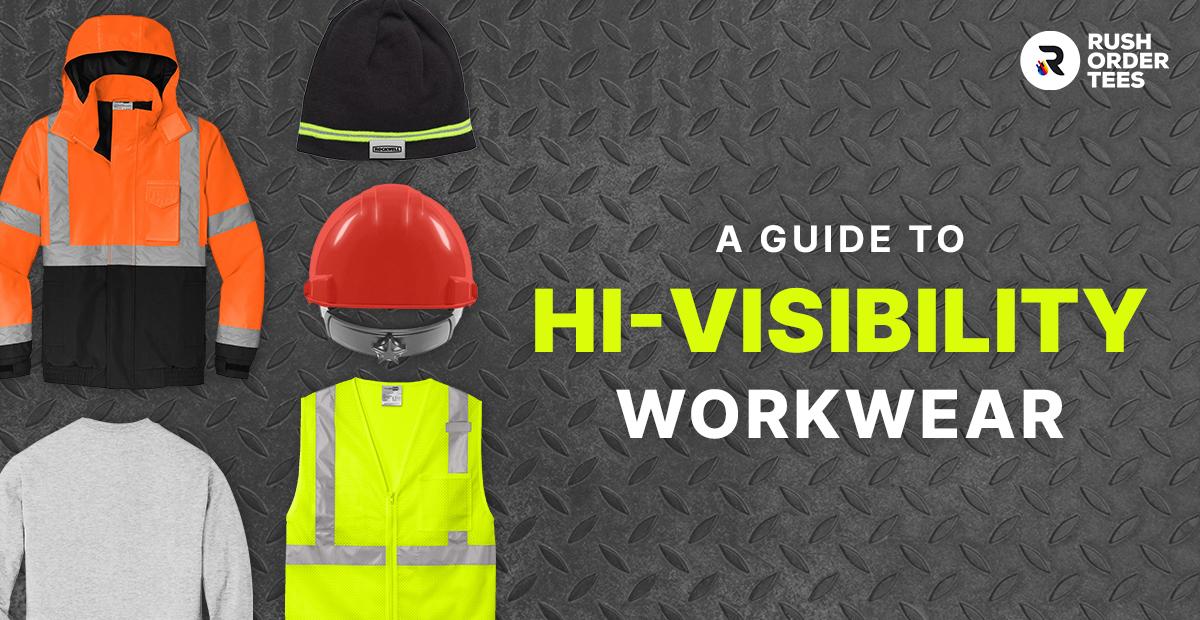

High-visibility workwear isn't just another category of custom apparel—it's literally life-saving equipment that comes with legal compliance requirements and the weight of keeping your crew safe. Unlike choosing between polo colors or fabric weights, selecting hi-vis gear means navigating ANSI standards, understanding class ratings, and ensuring your customization doesn't compromise safety certifications that could expose your company to liability.
Compliance is just the starting point; the right hi-vis workwear also needs to perform in your specific environment–whether that's scorching asphalt, freezing construction sites, or high-traffic warehouse floors—while keeping workers comfortable enough to actually wear it consistently.
It’s not too complicated. We’ll break down everything from Class 2 versus Class 3 requirements to fabric choices, customization best practices, and how to maintain safety standards while showcasing your brand. Because when visibility can prevent accidents, getting it right matters. Let’s make that happen.

What Is High-Visibility Workwear?
High-visibility workwear-–often called hi-vis clothing-–is specialized safety apparel engineered to make workers dramatically more noticeable in their work environment. This isn't for style reasons—it's about preventing serious injuries and fatalities by ensuring workers can be seen by vehicle operators, equipment drivers, and co-workers in challenging conditions.
The gear combines two key visibility technologies: vibrant fluorescent colors that provide contrast during daylight hours, and retroreflective materials that bounce light directly back to its source during low-light conditions. This dual approach means workers stay visible whether they're working under bright sun, overcast skies, or in darkness illuminated only by headlights or work lights.
Unlike regular workwear, hi-vis safety apparel must meet strict federal standards that dictate minimum amounts of fluorescent background material and retroreflective striping. These requirements aren't suggestions—they're legal mandates designed to reduce workplace accidents in environments where being seen can mean the difference between going home safe and becoming a statistic.
Typical Garments
high-visibility workwear spans a complete range of garments designed for different weather conditions, work environments, and safety requirements. Safety vests remain the most recognizable option—lightweight, affordable, and easy to throw on over existing clothing. But modern hi-vis lines include everything from breathable performance shirts for hot climates to insulated winter jackets for harsh weather.
Common garments include t-shirts and long-sleeves, hoodies, sweatshirts, jackets, rainwear, pants, bib overalls, and coveralls. Each type features the signature fluorescent colors—primarily safety orange and lime yellow—chosen specifically for maximum contrast against natural and urban backgrounds. Reflective striping is strategically placed to provide 360-degree visibility, with placement patterns varying based on the garment's intended safety class rating.
Today's wide variety of hi-vis apparel also incorporates performance features like moisture-wicking fabrics, stretch panels, and reinforced stress points. The goal is creating safety gear that workers will actually want to wear consistently, since the best hi-vis clothing in the world won't protect anyone if it's hanging in a locker instead of being worn on the job site.
Key Industries
high-visibility workwear serves as essential safety equipment across numerous industries where worker visibility directly impacts survival. The common thread isn't the type of work—it's the presence of moving vehicles, heavy equipment, or low-visibility conditions that create serious hazards.
- Construction: Road crews, site workers, surveyors, flaggers, and equipment operators
- Transportation & Logistics: Highway maintenance, railroad workers, airport ground staff, shipping and receiving personnel
- Utilities: Electrical linemen, gas and water utility crews, telecommunications technicians
- Emergency Services: Police officers, firefighters, paramedics, disaster response teams, tow truck operators
- Warehousing: Forklift operators, loading dock personnel, inventory management teams
- Municipal Services: Street crews, waste management, parking enforcement, crossing guards
- Events & Entertainment: Concert security, festival staff, parking attendants
- Industrial Facilities: Manufacturing plants, chemical processing, oil and gas operations
- Security Services: Private security, traffic control, crowd management
The unifying factor across all these industries is risk exposure; whether from fast-moving traffic, heavy machinery, poor lighting conditions, or complex backgrounds that can camouflage workers. Investing in compliant hi-vis workwear is about creating a culture of safety that protects your most valuable assets: your people.

Understanding ANSI/ISEA Classes
ANSI/ISEA 107 serves as the definitive safety standard in the United States for high-visibility workwear, establishing clear requirements that could literally save lives. This standard is a systematic approach to ensuring workers remain visible in hazardous environments by classifying garments based on the amount and strategic placement of fluorescent background material and retroreflective striping.
The classification system removes guesswork from safety decisions. Rather than hoping a bright shirt will keep workers safe, ANSI/ISEA 107 provides measurable criteria that define exactly how much visibility material is required for different risk levels. This scientific approach has proven effective in reducing workplace accidents across industries where being seen prevents injuries and fatalities.
Garment Classes and Their Purposes
The ANSI/ISEA standard defines four distinct performance classes, each engineered for specific risk environments and visibility needs. These aren't arbitrary categories—they're based on extensive research into accident patterns, visibility requirements, and real-world workplace hazards.
- Class 1 provides the most basic level of visibility protection, suitable for workers who operate away from vehicular traffic and moving equipment in relatively controlled environments. These garments contain the minimum required amounts of fluorescent and retroreflective material, making them appropriate for warehouse work, parking lot maintenance, or other low-risk settings where full visibility isn't critical for survival.
- Class 2 significantly increases visibility for workers exposed to moderate risk conditions, particularly those working near roadways with traffic speeds under 50 mph or in environments with complex visual backgrounds. Class 2 garments feature substantially more fluorescent background material and additional retroreflective striping compared to Class 1. You'll commonly see Class 2 requirements for utility workers, road construction crews, and airport ground personnel.
- Class 3 delivers maximum visibility protection for high-risk environments where workers face fast-moving traffic, poor lighting conditions, or situations where their complete body silhouette must remain visible. Class 3 apparel covers significantly more of the worker's body with both fluorescent and retroreflective materials, typically requiring long sleeves and full-coverage designs. This class is mandatory for highway workers, emergency responders, and anyone working in high-speed traffic zones.
- Class E (Enhanced Visibility) specifically covers high-visibility pants, shorts, and bib overalls. These garments don't qualify as standalone Class 1, 2, or 3 protection when worn alone. However, when a Class E bottom is combined with a Class 2 or Class 3 top, the complete ensemble achieves Class 3 rating for maximum conspicuity and full-body coverage.
Types and Application Environments
Beyond the class system, ANSI/ISEA 107 also defines three distinct "types" based on specific workplace environments and the unique hazards workers face in those settings.
Type O (Off-Road):
- Environment: Off-road work sites with minimal vehicle exposure
- Applications: Warehouses, industrial facilities, oil and gas operations, mining sites
- Risk Level: Lower vehicle interaction, controlled access environments
Type R (Roadway):
- Environment: Public roadways and areas with vehicular traffic exposure
- Applications: Highway construction, road maintenance, transportation work, traffic control
- Risk Level: Direct exposure to public vehicle traffic and construction equipment
Type P (Public Safety):
- Environment: Emergency response and public safety scenarios
- Applications: Police work, fire departments, emergency medical services, incident response
- Risk Level: Variable and unpredictable environments requiring maximum adaptability
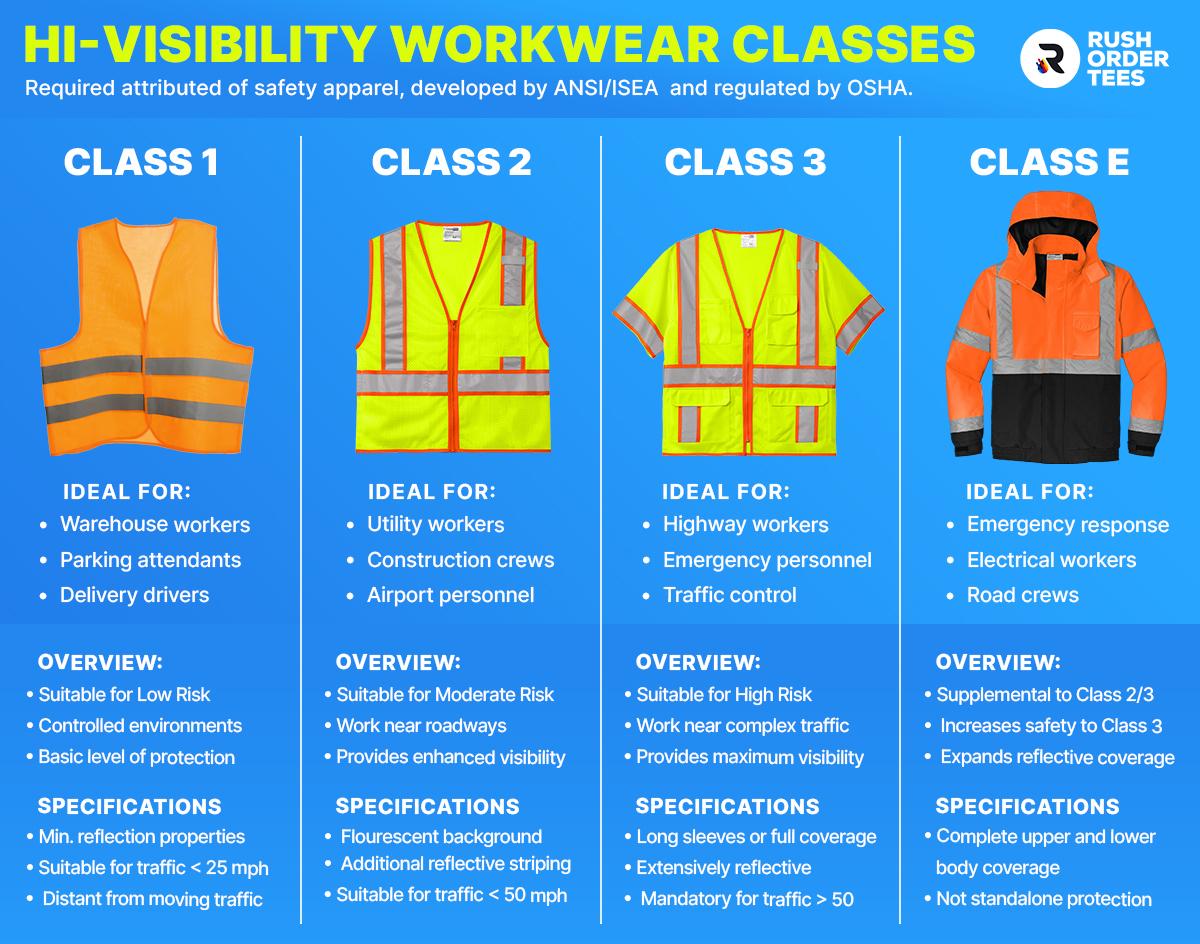
Proper selection requires analyzing multiple factors: proximity to traffic, vehicle speeds, lighting conditions, weather exposure, and background complexity. A utility crew working on rural power lines faces different hazards than highway flaggers or emergency responders at accident scenes. Each scenario demands specific visibility solutions.
The key is matching the class and type to actual working conditions rather than defaulting to the minimum requirements. When in doubt, choosing higher-class protection provides better safety margins, and many companies opt for Class 3 as their standard to ensure consistent protection across varying job sites and conditions.
Popular High-Visibility Garments
high-visibility workwear encompasses several distinct categories of safety apparel, each designed to meet specific environmental challenges and ANSI compliance requirements. Here's a breakdown of the main types with popular examples from our catalog:
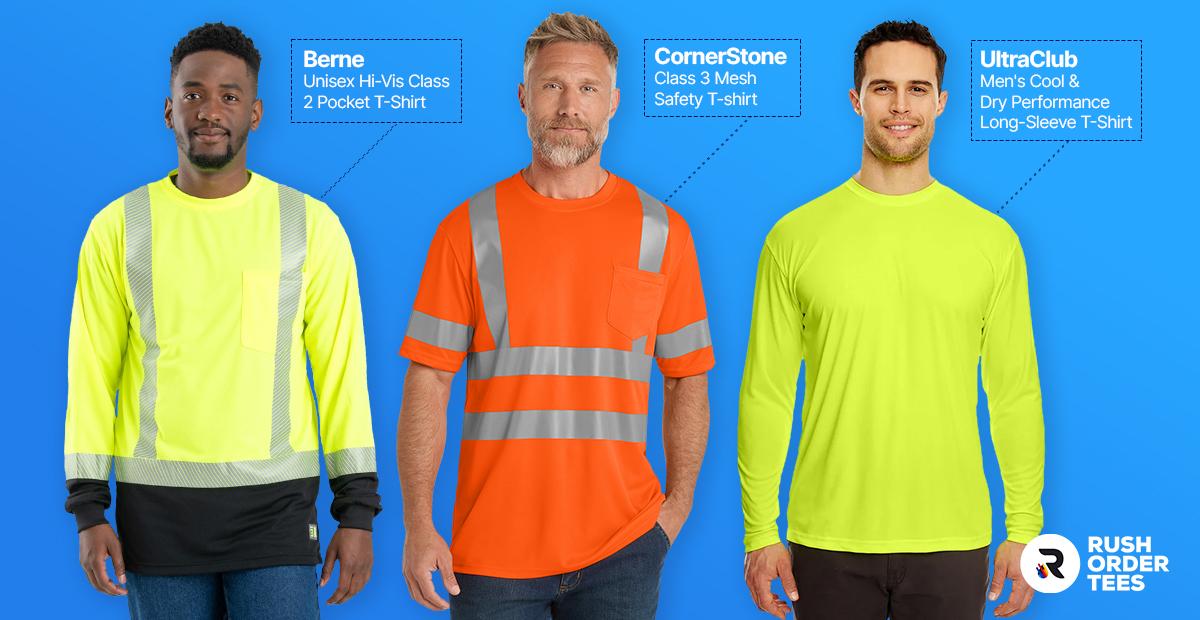
Safety Shirts (Short and Long Sleeve)
High-visibility safety shirts offer breathable, moisture-wicking protection for workers in warmer climates or high-activity environments. These lightweight garments feature synthetic blends that keep workers cool while maintaining ANSI-compliant fluorescent colors and retroreflective striping. Available in both short and long sleeve versions, they're ideal for construction crews, utility workers, and landscaping teams who need freedom of movement without the bulk of traditional safety gear.

Safety Vests
Safety vests remain the most popular hi-vis option due to their affordability, versatility, and ease of customization. These lightweight garments slip over existing clothing, making them perfect for visitor safety, general construction, warehouse operations, and traffic control. Their generous surface area accommodates company logos and branding while maintaining compliance, and their low cost makes outfitting large crews or providing temporary safety gear economical.

Safety Hoodies
Hi-vis hoodies provide thermal comfort for cooler weather while maintaining visibility requirements. These garments feature warm fleece interiors, weather-resistant exteriors, and strategic retroreflective placement that works with the hood design. They're essential for road crews, utility workers, and anyone working outdoors during fall, winter, or early morning conditions when temperatures drop but visibility remains critical.
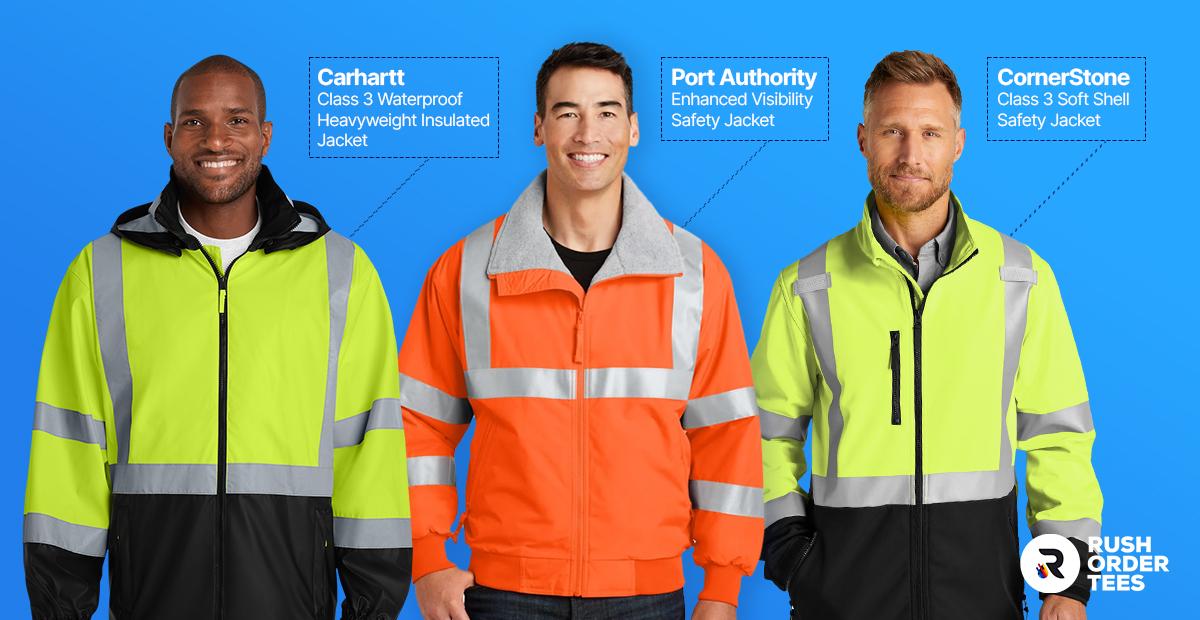
Safety Jackets
Safety jackets deliver serious weather protection with insulation, wind resistance, and waterproof features while maintaining ANSI compliance. These heavyweight garments often feature removable linings, adjustable cuffs, and multiple pockets for tools and equipment. They're designed for harsh winter conditions, emergency responders, and workers who spend extended periods outdoors in challenging weather.
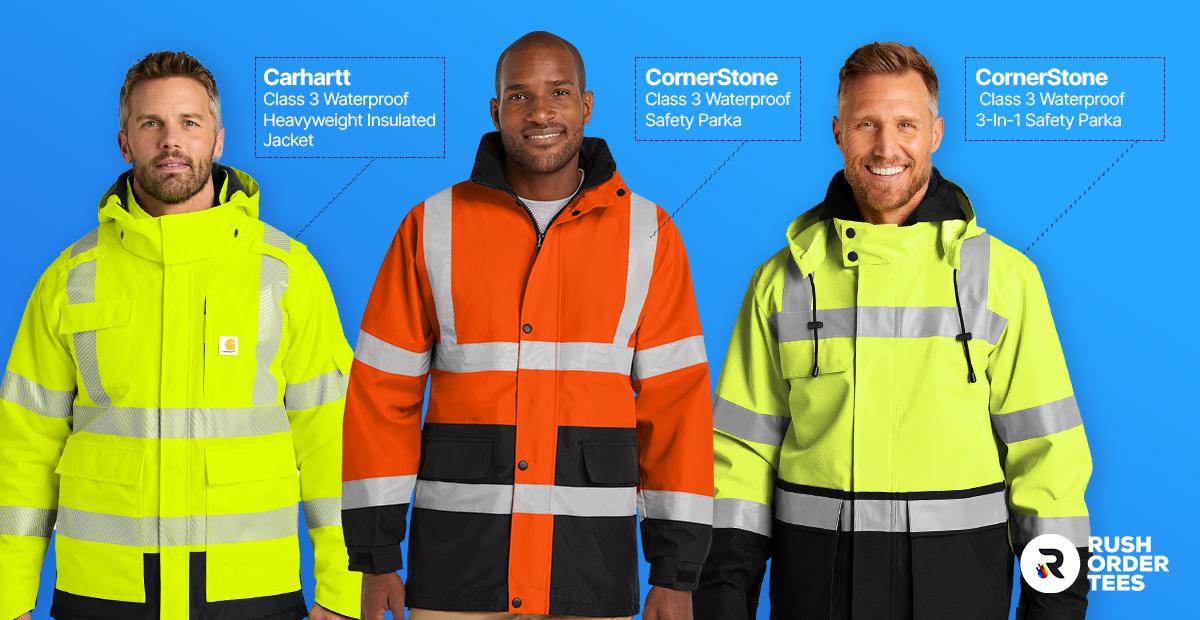
Safety Rain Gear
Hi-vis rain jackets combine waterproof protection with visibility requirements, featuring sealed seams, breathable membranes, and strategic retroreflective placement that remains effective when wet. These specialized garments ensure workers stay dry and visible during storms, making them essential for emergency crews, road maintenance, and any outdoor work that continues regardless of weather conditions.

Safety Hats
High-visibility safety hats provide head-level visibility and warmth in colder climates. These fluorescent beanies and caps feature reflective accents and bright colors that complement full hi-vis uniforms. While not typically required by ANSI standards, they enhance overall visibility and provide a professional finishing touch for crews working in low-light or cold weather conditions.
Example High-Visibility Workwear Products
While we carry premium hi-vis brands like Kishigo, Carhartt, and Berne, we're featuring CornerStone products here because they offer the most reliable combination of quality, selection, and budget-friendly pricing. CornerStone provides comprehensive coverage across all hi-vis categories with consistent ANSI compliance and excellent customization compatibility:
CornerStone Class 3 Mesh Safety T-shirt (CS202)

The CornerStone Class 3 Mesh Safety T-Shirt is designed for jobs demanding maximum visibility and comfort. Made of breathable, 100% polyester birdseye mesh, this moisture-wicking tee keeps workers cool during strenuous activity. Key features include 2-inch reflective tape around the body and sleeves for 360-degree ANSI Class 3 visibility, a rib knit neck for durability, and a convenient left chest pocket. Ideal for road crews, utility workers, and those working in high-traffic or low-light outdoor environments who need a lightweight, highly visible base layer.
Class 2 Mesh Long Sleeve Safety T-shirt (CS201)

The CornerStone Class 2 Mesh Long Sleeve Safety T-shirt offers enhanced coverage while keeping comfort a priority. It features breathable, moisture-wicking 100% polyester mesh fabric, 2-inch ANSI-compliant reflective tape for visibility, rib knit neck and cuffs, back neck tape for comfort, and a left chest pocket. This garment is particularly well-suited for moderate-risk worksites—like traffic control, utility maintenance, and general construction—where increased arm coverage boosts safety.
Class 2 Mesh Zippered Safety Vest (CSV102)
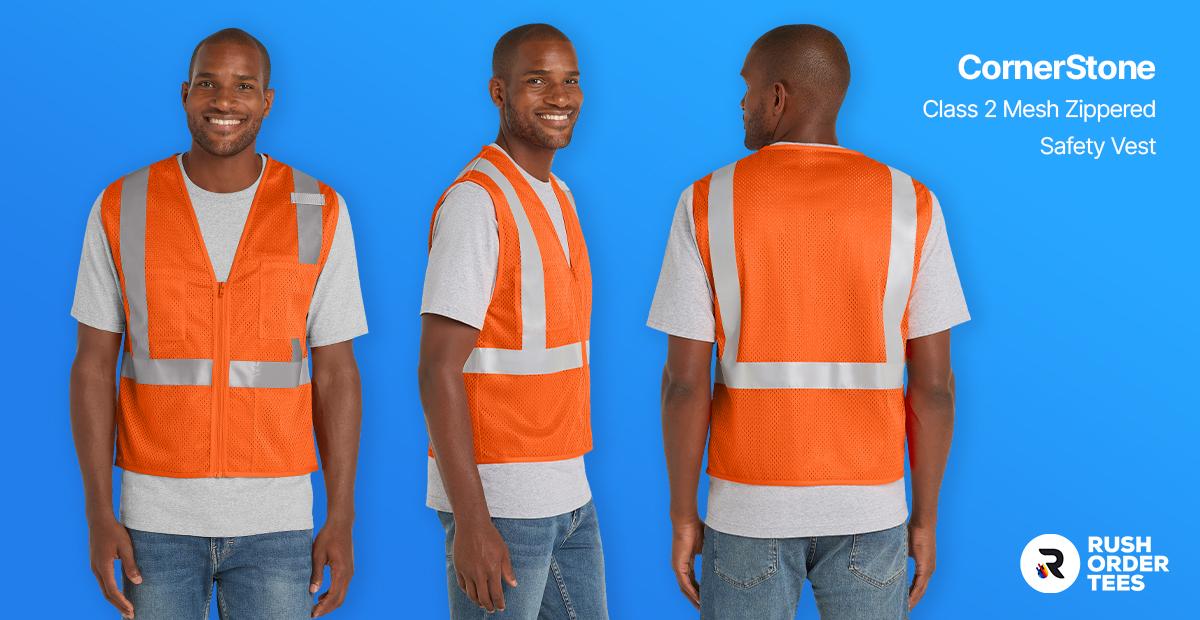
The CornerStone Class 2 Mesh Zippered Safety Vest delivers reliable visibility with added workplace functionality. Constructed of durable, breathable polyester mesh, it meets ANSI 107 Class 2 standards with 2-inch reflective tape and multiple storage pockets for essential tools and accessories. A mic clip at the chest offers additional practicality for team communication. This vest is perfect for supervisors, parking attendants, event staff, or general contractors needing both compliance and convenience in settings with moderate traffic or equipment movement.
CornerStone Class 3 Surveyor Mesh Zippered Safety Vest (CSV106)
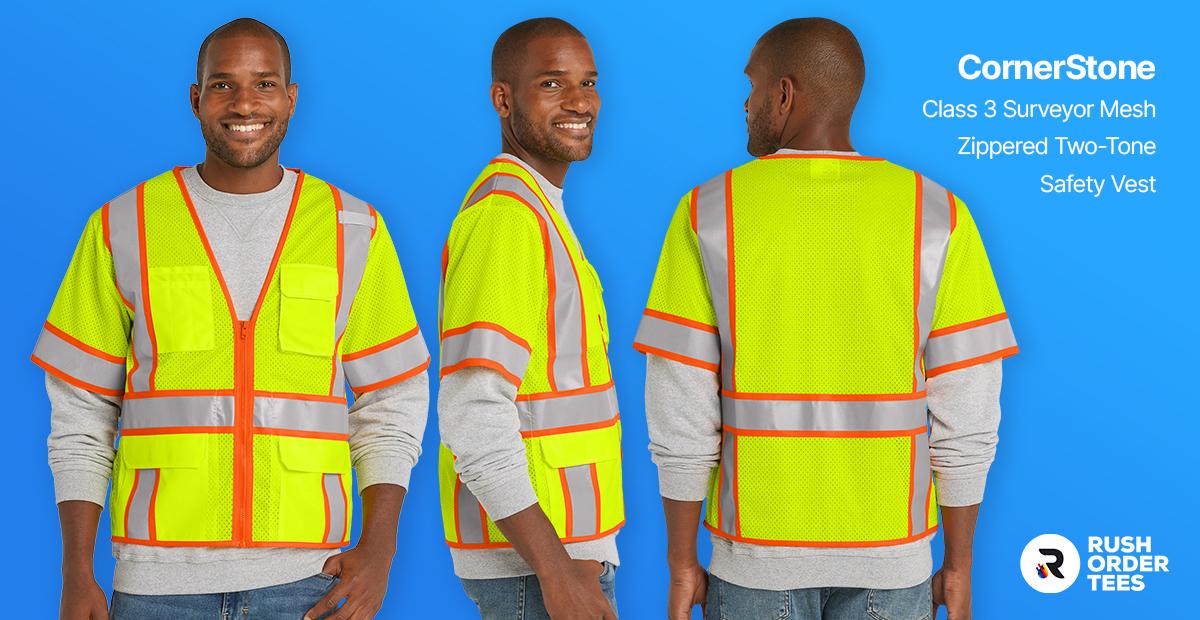
The CornerStone Class 3 Surveyor Mesh Zippered Two-Tone Safety Vest is built for professionals needing the highest ANSI visibility. This vest features short sleeves, breathable mesh for comfort, and multiple durable tricot pockets, including a bellows pocket, layered chest pockets, and lower front flap pockets. Reflective tape ensures Class 3 360-degree visibility. Enhanced with a mic clip and zippered closure, this vest is ideal for surveyors, construction site leaders, and crew managers in complex, high-risk environments.
Class 3 Waterproof Safety Parka (CSJ502)
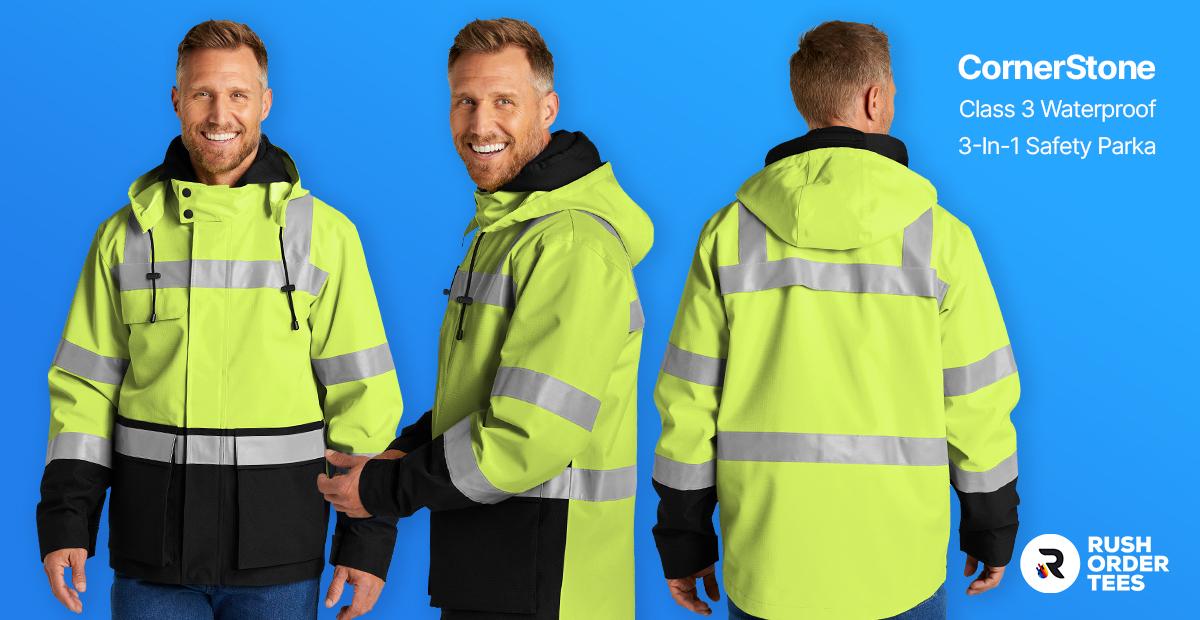
The CornerStone Class 3 Waterproof 3-In-1 Safety Parka is a versatile 3-in-1 solution, offering layering options for variable weather without compromising safety. All components are ANSI Class 3 compliant, and the system is designed for stormy worksites where both warmth and dryness are essential. Its robust construction, reflective tape, and waterproof materials make it an excellent choice for highway workers, emergency response teams, and utility crews in challenging climates.
Class 3 Safety Windbreaker (CSJ125)
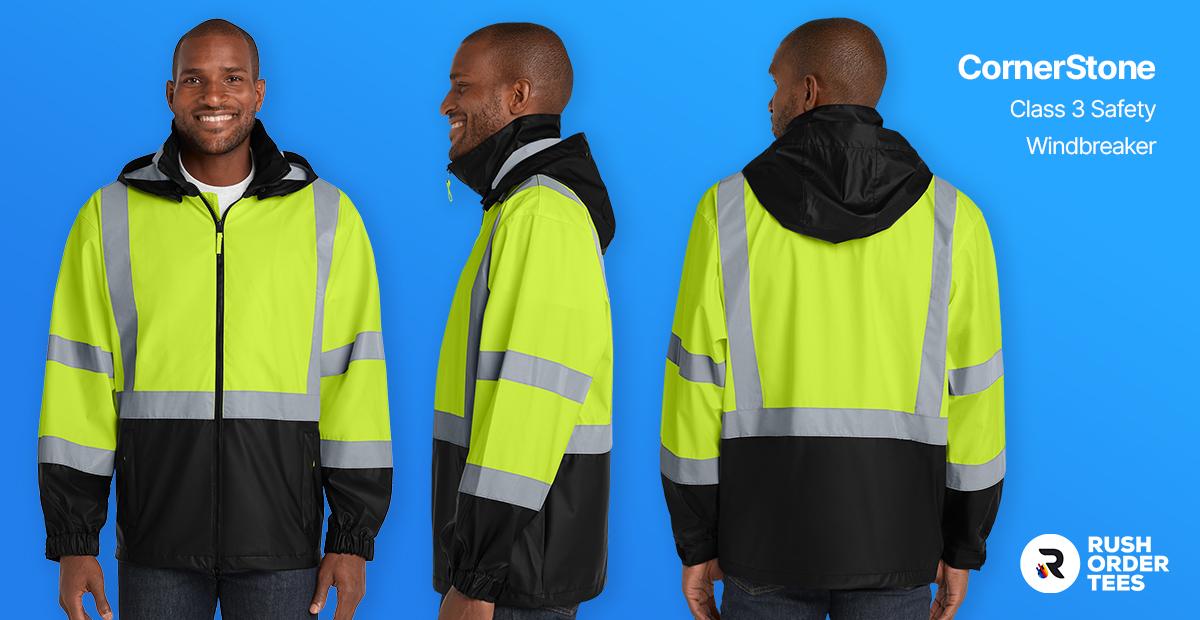
The CornerStone Class 3 Safety Windbreaker delivers lightweight comfort, water resistance, and advanced visibility. It features a 100% polyester shell with PU coating, an 8,000MM waterproof rating, 2-inch reflective tape, adjustable snap-off hood, internal storm flap, and zippered pockets. This windbreaker ensures compliance in wet or windy conditions, suiting municipal workers, flaggers, and outdoor contractors who operate in unpredictable weather.
Class 3 Economy Waterproof Safety Jacket (CSJ500)
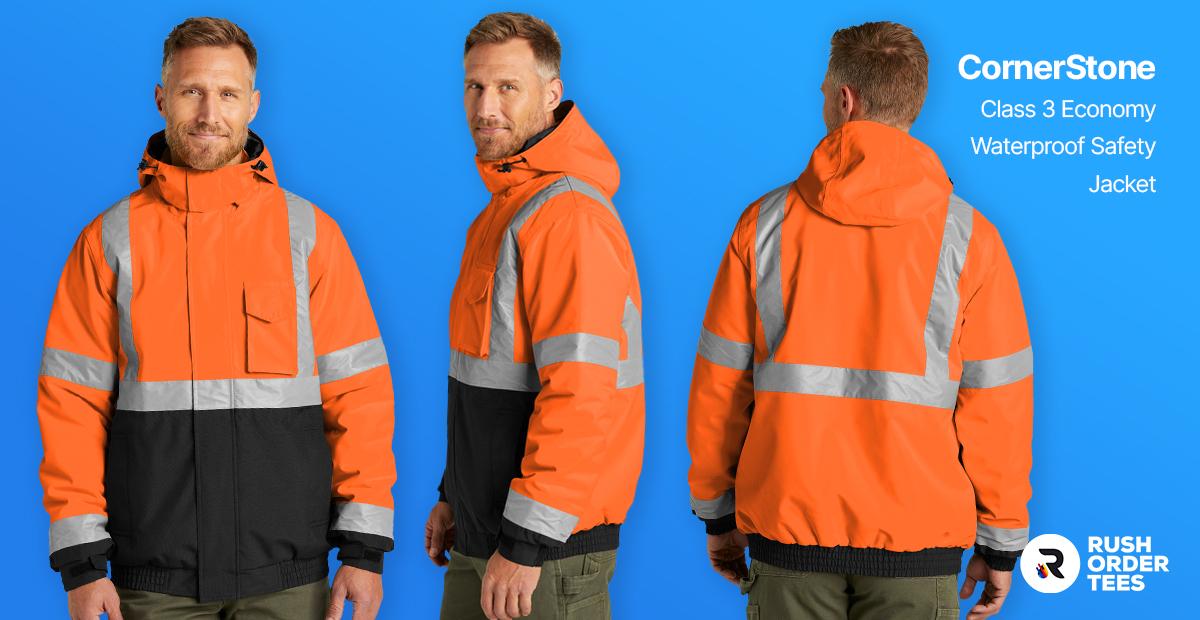
The CornerStone Class 3 Economy Waterproof Safety Jacket is fully seam-sealed and insulated, providing complete Class 3 visibility and robust protection for adverse weather. Made of 300-denier polyester oxford with polyfill insulation and black lower panels to mask dirt, it boasts 5,000MM waterproof and breathability ratings, a zip-removable hood, and multiple functional pockets. This jacket is a preferred solution for outdoor crews working in rain, snow, and cold—such as road repair, traffic management, and public utilities.
Class 3 Heavy-Duty Full-Zip Safety Hoodie (CSF300)

The CornerStone Class 3 Heavy-Duty Full-Zip Safety Hoodie combines warmth, comfort, and full ANSI Class 3 compliance. Constructed from heavyweight, smooth-faced 100% polyester fleece with a black bottom and cuffs to hide grime, it features 2-inch reflective taping, a three-panel hood with drawcord, and practical pouch pockets. This hoodie is well-suited for tradespeople, nighttime crews, and teams operating in cool or unpredictable weather needing comfort without sacrificing safety.
Reflective Stripe Safety Beanie (CS800)
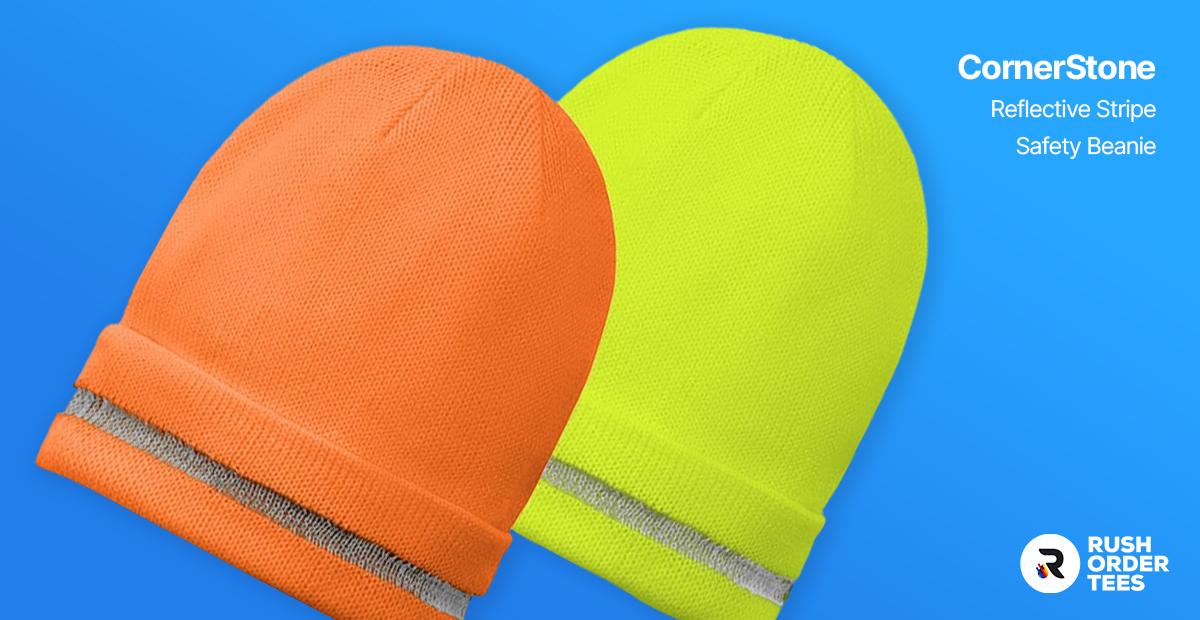
The CornerStone Reflective Stripe Safety Beanie improves head-level conspicuity for workers in colder weather or lower-light situations. Made from hi-vis, fluorescent fabric, often with optional reflective accents, it is a simple yet effective addition to uniforms for road crews, construction workers, and utility teams during early mornings, evenings, or winter months, ensuring no part of the worker is overlooked in hazardous environments.
Customization Considerations for Hi-Vis Gear
When customizing high-visibility workwear, safety compliance must remain the top priority while achieving your branding goals. These key considerations ensure your custom hi-vis gear maintains its protective function while showcasing your company identity:
Logo Placement
Proper logo placement on hi-vis workwear requires avoiding reflective tape areas and fluorescent zones critical for ANSI compliance. The ideal locations are typically on the left or right chest above reflective strips, or on the upper back in designated areas that won't compromise visibility features. Each garment type has specific safe zones for customization, and our team will work with you to determine the best placement that maximizes brand visibility while maintaining safety standards.
Decoration Methods
Screen printing and DTF (direct-to-film) transfers are the most effective decoration methods for hi-vis workwear. Screen printing works well for simple logos using standard black ink that provides excellent contrast against fluorescent backgrounds. DTF transfers are proving especially excellent for this purpose, offering superior durability and flexibility that moves with the garment while maintaining crisp detail. Embroidery is possible on heavier garments like jackets and hoodies, but should be limited to areas clear of reflective materials.
Material Compatibility
Hi-vis garments are typically constructed from synthetic materials or moisture-wicking blends that may present compatibility challenges with certain decoration methods. Some fabrics can be sensitive to heat or require special considerations during the customization process. At RushOrderTees, we're experts in hi-vis decoration and will advise the best approach for your specific garments, ensuring optimal results without compromising fabric performance or safety features.
Compliance Impact
Improper customization can potentially void ANSI certification if decoration interferes with required fluorescent or reflective areas. However, when working with experienced decorators who understand hi-vis requirements, this isn't a concern. At RushOrderTees, we ensure all customization maintains compliance standards by using proven placement templates and decoration methods that have been tested to preserve safety certifications. We've got the expertise to keep your team safe and your brand visible.
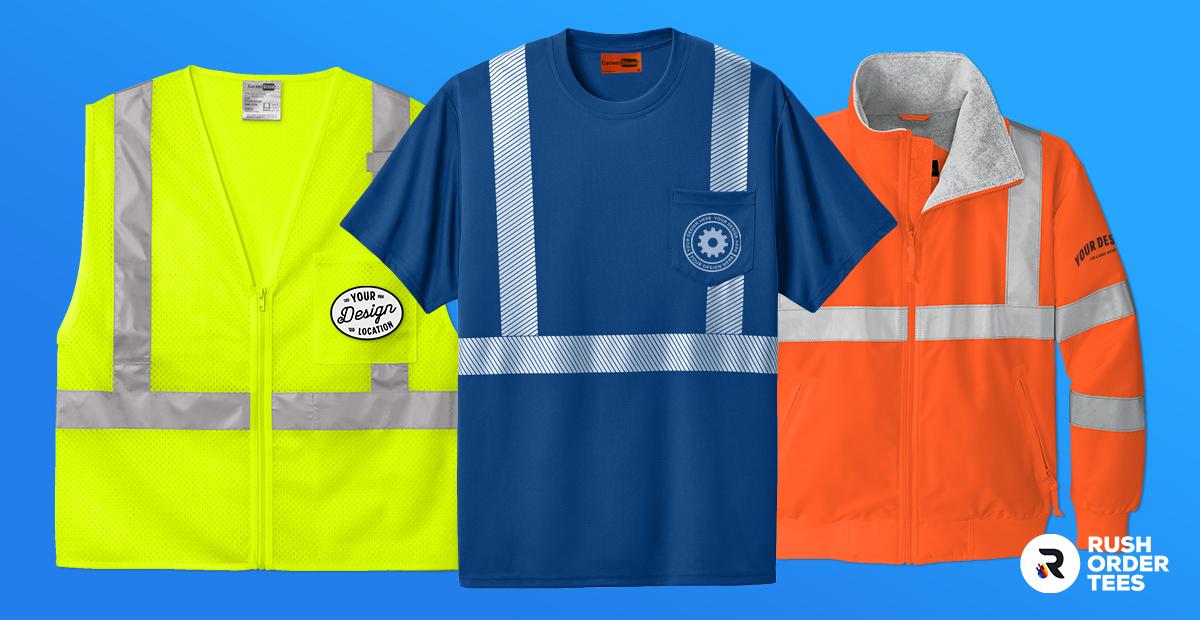
Balancing Safety and Branding
Effective hi-vis customization requires strategic thinking to maximize brand impact while preserving safety function. These expert tips help you achieve professional results:
- Use black ink for maximum contrast - Black prints are by far the most popular and best option for visibility against fluorescent backgrounds, creating the sharp contrast needed for easy recognition.
- Adjust for black safety apparel - On black hi-vis garments, use white ink or match the fluorescent accent colors to maintain proper contrast and readability.
- Simplify logos and strip details - Remove small text, fine lines, and intricate elements that won't read clearly at typical logo sizes on safety gear.
- Skip contact information - Avoid cluttering designs with phone numbers, addresses, or websites unless your web address differs significantly from your business name.
- Utilize pocket space - Look for opportunities on chest pockets where small logos can fit nicely without interfering with main reflective areas.
- Use shoulder areas for text - The space across shoulders provides ideal placement for employee names, department titles, or operational roles in larger text.
- Compare styles within categories - Different vest styles, jacket cuts, and shirt designs offer varying customization opportunities, so explore options within each category.
- Test sizing at home - Print your logo design on paper, cut it out, and position it on a sample garment to evaluate fit, readability, and visual balance before finalizing size.
- Avoid upper back on hoodies - Don't place logos on the upper back of hooded garments since the hood will cover the design when worn down.
- Consider garment color combinations - Some hi-vis garments feature multiple fluorescent colors or contrasting panels that can enhance logo placement options.
- Plan for laundering - Choose decoration methods that withstand industrial washing cycles common in safety-critical workplaces.
Getting Your Hi-Vis Order Right
Before placing your order, following these best practices ensures you select compliant safety gear that meets your specific needs while achieving effective branding:
- Assess your ANSI class requirements - Evaluate your work environment's risk level, traffic exposure, and lighting conditions to determine whether you need Class 1, 2, or 3 protection for compliance and safety.
- Match garments to working conditions - Consider climate demands, physical activity levels, and layering requirements when choosing between shirts, vests, hoodies, jackets, or rain gear for optimal worker comfort.
- Plan customization details upfront - Determine your logo size, placement preferences, and decoration method before ordering to streamline the process and avoid compliance issues.
- Request samples for team orders - When outfitting multiple workers, order sample garments or review detailed sizing charts to ensure proper fit across different body types and preferences.
- Work with experienced hi-vis decorators - Partner with customization providers who understand ANSI compliance requirements and can guide you through safe logo placement and decoration methods.
- Consider seasonal and task variations - Plan for different garment types if your crew works year-round or performs varied tasks requiring different levels of protection and mobility.
- Budget for proper quantities - Factor in replacement needs, laundering rotation, and having backup gear available to maintain consistent safety standards.
- Document compliance requirements - Keep records of ANSI certifications and decoration specifications to demonstrate regulatory compliance during inspections or audits.
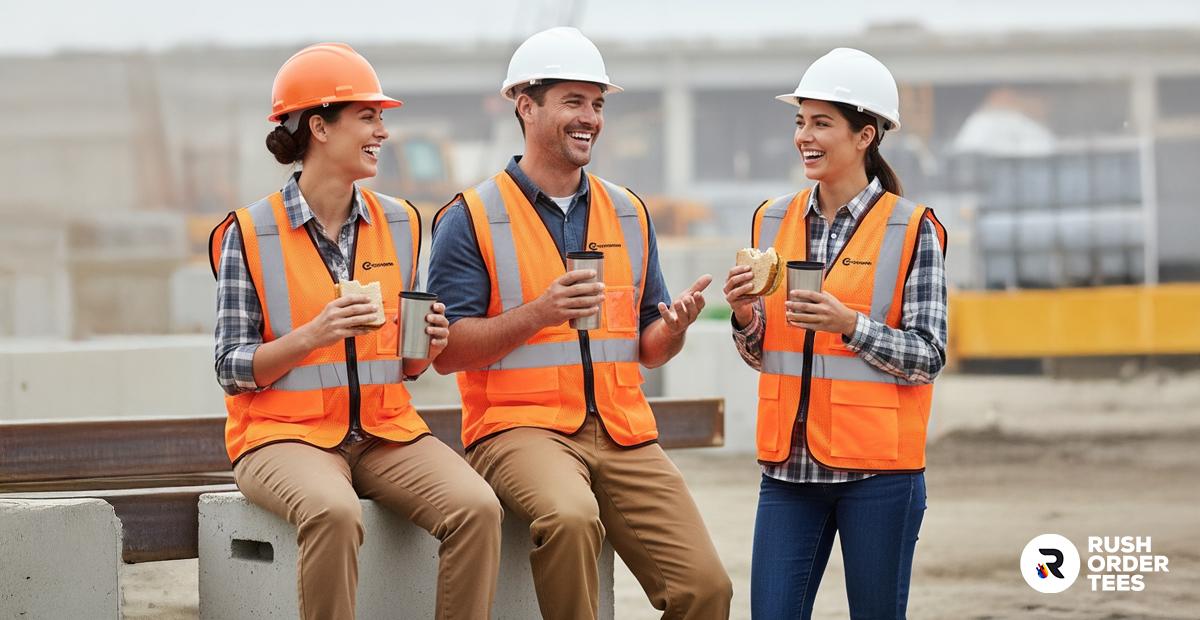
Stay Safe, Stay Visible, Stay Branded
High-visibility workwear is more than meeting regulations—it's about protecting your most valuable assets while maintaining professional brand presence. The right combination of ANSI-compliant gear and strategic customization creates safety equipment your crew will be proud to wear.
Whether you need safety shirts, vests, hoodies, jackets, rain gear, or safety hats, our team understands both the technical requirements and customization possibilities. We'll guide you through class selection, optimal logo placement, and decoration methods that maintain compliance while showcasing your brand. Get your custom hi-vis workwear quote today from RushOrderTees.

About the Author
A graduate of the Multimedia program at the University of the Arts in Philadelphia, Imri Merritt is an industry veteran with over 20 years of graphic design and color separations experience in the screen printing industry.
